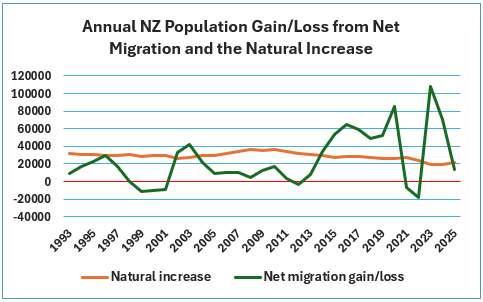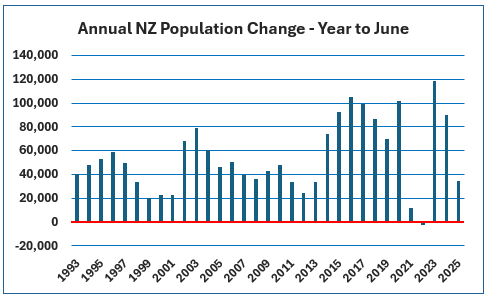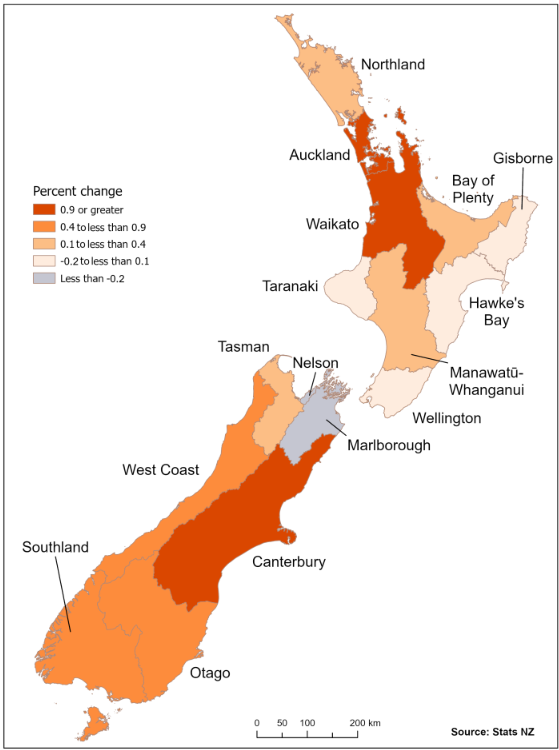
The natural increase in New Zealand's population has exceeded the net gain from migration for the first time since 2013, apart from the Covid-19 pandemic affected years of 2021 and 2022.
Latest Statistics NZ figures show the natural population increase, the number of births minus the number of deaths, was 21,000 in the 12 months to June this year.
That was the third successive annual rise in the natural increase in population, bringing an end to the steady decline that occurred from the peak of 36,200 in the year to June 2010, to 19,100 in the year to June 2023. (The first graph below shows the annual trend since 1993).
Added to that was the net population gain from migration, long-term arrivals minus long-term departures. This dropped sharply to 13,700 in the year to June 2025 from 70,400 in the 12 months to June 2024.
Apart from the pandemic affected years of 2021/22, that was the lowest net migration gain since 2013. (Annual net migration trends are also shown in the first graph below).
Added together, the 13,700 net gain from migration and the natural increase of 21,000, gave NZ a total population gain of 34,700 in the 12 months to June this year, pushing the total population up to 5.3 million people.
Apart from 2021/22, that's the lowest annual increase for the June year since 2013. (The second graph below shows the annual trend).
That means the population increased by 0.66% in the 12 months to June this year, down from growth of 1.73% in the year to June 2024 and 3.33% in the year to June 2023.
Apart from 2021/22, that's the lowest rate of increase for that period since 2012.
While population growth is at a much lower level than previous years, it is likely also at a much more sustainable level in terms of the strain it places on infrastructure such as housing and transport ,and services such as health and education, which have come under immense pressure during previous periods of high population growth.
Around the country the fastest growing region was Canterbury, with annual population growth of 1.1% in the 12 months to June this year, followed by Auckland and Waikato, both on 1.0%.
At the other end of the scale Nelson and Marlborough had negative population growth of -0.3% in the year to June, followed by Gisborne and and Hawke's Bay on -0.1%. The Wellington Region and Taranaki had static populations in the year to June. (See the final chart below for the full regional figures).
The comment stream on this article is now closed.



12 Comments
When the economy is bad, there’s still one form of free entertainment.
Free? More like buy now, pay later.
This guy chose not to retire: https://www.stuff.co.nz/culture/360868483/kelsey-grammer-70-announces-b…
It’s like a one time sale, never to be repeated.
The natural increase in New Zealand's population has exceeded the net gain from migration for the first time since 2013
long may it last
It will take almost 50 years to add another 1 million people at this rate and not 5 years like in the days of uncontrolled immigration. About time.
Your typical politician or government agency/planning worker: "We had a housing crisis which we didn't know how to solve but we were flooding the country with the population of Dunedin or Hamilton on a yearly basis....how could we have possibly known a solution to this housing problem we were facing?"
Um close the borders for a few years might do it.
Current births are 25% below replacement - babies are not a driver of natural population growth. Any population growth is political - by politicians and for politicians desperate to eke out some GDP growth in a public service welfare state with some houses thrown in.
“With no migrant arrivals or migrant departures, New Zealand’s population is projected to peak at just under 5.5 million in the early 2040s then slowly decline as deaths outnumber births.
Natural increase is no longer the main driver of New Zealand’s population growth.”
https://www.stats.govt.nz/news/new-zealands-population-likely-to-reach-…
I’ve read some where that over half of NZers will receive more from government than they give over their lifetimes. So why not create immigration policy by modelling jobs that will be in the net benefit portion of the population and provide open doors to those professions and close avenues to any that will end up being a net drain on the state? Obviously there will need to be some refining but I’m sure modelling would ascertain what jobs will be above and below this threshold.
There’s clearly moral debate around Kiwis then being down skilled etc but we have to start somewhere with a credible immigration policy.
Because simple earnings and ability to earn above the thresholds to not be a drain does not necessarily correlate to value to country.
Five fruit pickers on minimum wage will likely earn the country more than five bank managers on $250k.
We need to actually value productive capacity, pay accordingly. Nah just joking, not gonna happen.
We need to actually value productive capacity, pay accordingly.
Agreed, but so long as there is a cheaper alternative, it will never be so. Cheaper labour, chemicals and fertilisers to make things easier and improve yeilds.
Well I've recently contributed to this. Sorry PDK but there's a new interesting wee one consuming resources in the household here.


We welcome your comments below. If you are not already registered, please register to comment.
Remember we welcome robust, respectful and insightful debate. We don't welcome abusive or defamatory comments and will de-register those repeatedly making such comments. Our current comment policy is here.